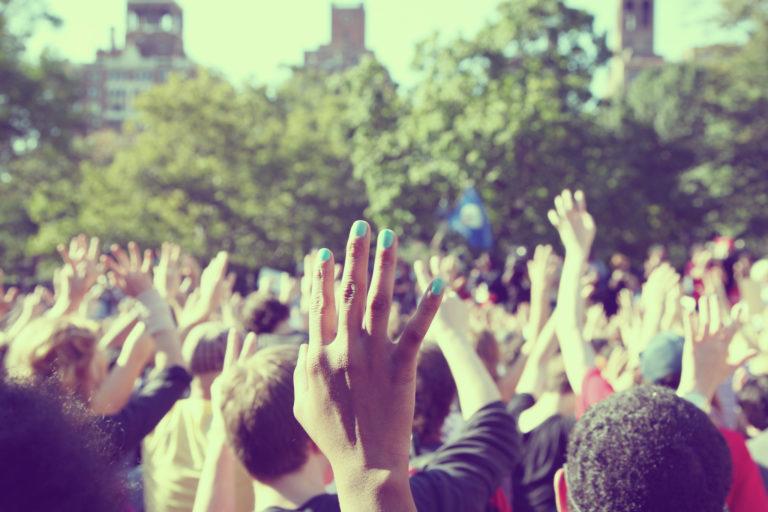Letters to the Living No. 2: How Can I Reach You Over These Distances?
“Thousands of mourners filled the massive Friendly Temple Missionary Baptist Church in St. Louis for the funeral [of Michael Brown], which began with upbeat music punctuated by clapping. Some of the mourners danced in place…” From the Associated Press
I hear their voices, and stop in my tracks. The Tennessee oaks branch overhead. Suddenly, I am crying. The singing moves through the airwaves into my body, and releases memories of my mother, racial injustice, and my own journey to understand how beauty can come from even the deepest wounds.
The voices are those of Aboriginal women, who met in Alice Springs in June, to share the music of faith and freedom with the Soweto Gospel Choir of South Africa. One these Indigenous Australian choirs is conducted by Morris Stuart, originally from Guyana, a descendent of African slaves.
The story of Morris and his wife, Barbara, a white Australian artist, is incredible. It was Barbara’s desire to visit the Outback and meet with Indigenous communities that stirred into motion what became the Asante Sana Choir of Indigenous Women. But the approach of Morris and Barbara as they visited these communities was one of consultation and mutual learning, not cultural tourism or problem-solving:
“I would characterize the whole exercise as building respect and building relationships…I can’t emphasize too strongly that we didn’t go there to solve anybody’s problems…Rather we felt as other human beings, we had things to share and things to learn and that’s the spirit with which we approached the whole matter.”
In the months before she died, I sat with my mother in our big white bed in the Maryland suburbs and recorded her stories. At 22, she had traveled from rural North Dakota to Australia on a teacher-exchange program. This was 1974. She was deeply hurt and troubled by what she had observed of racism in the United States — but found the situation identical if not worse in Australia. She moved farther and farther into the Outback to learn more about Aboriginal culture, finally ending up on a tiny island in the East Timor Sea.
As I listened to Morris and Barbara speak about building relationships with Indigenous people, my mother’s story echoed in my heart:
“You know, Andréana, building friendship with Aboriginal or any people is like building friendship anywhere in the world. You’re interested in somebody and so you ask about them, you inquire about them…about the way they live, how they hunt, everyday things. And you begin to build relationship. And slowly they ask about you, and you go back and forth. Basically, if you’re truly genuinely sincere, people everywhere in the world respond to sincerity.”
To circle back to my story, which also took me abroad to Europe, where my grandparents originated. Ever since I first encountered Roma people on my visit to Hungary at 14, their stories have stayed inside me. I began to learn more and discovered a legacy of racism, enslavement, and attempted extermination (during the Holocaust) just as heart-breaking as that of African Americans and Indigenous peoples. Even today, many Roma children are put into segregated schools or “special classes” for the mentally handicapped. De facto exclusion exists almost everywhere there are Roma communities.
Since my grandparents came from Europe, they surely had some knowledge of the “Gypsies,” as they were called back then. Most likely, they held some negative assumptions about a people they probably had very little contact with. This is only speculation on my part; I never met my Hungarian grandparents. But like my mother, somewhere deep I feel called to build relationships across culture lines too.
I spent a year and a half in Hungary, meeting and making friends with many Roma individuals. When I returned to the U.S. this year, I landed in Chicago. On the Fourth of July weekend, newspapers reported that 14 people were killed and more than 60 injured — mainly African Americans — in gun-related violence.
I know this is not surprising news (which is horrible) for many, especially for Chicago’s South Side. It should be shocking. It should be gut-wrenching. But instead, the numbers and race of the individuals killed blurs into an indiscriminate mass, and we carry on — until Michael Brown is shot, and suddenly, the masses have a name and face.
Later that month, I drove from Chicago to Tennessee to stay in my father’s home. On August 9th, the web exploded with news of Michael’s Brown’s death at the hands of white police officers, one state away in Missouri.
I had gone to central Europe to find methods of healing social injustice and came home to find its bloody handprint on my very doorstep.
But let’s return to the music coursing through my body on this sun-filled afternoon, under the Tennessee oaks. It’s “Amazing Grace” sung by a choir of Indigenous women — in their own language — in the red center of Australia.
In my mind’s eye, I am at my mother’s funeral again. The world is smeared and incoherent, except for one clear light. A tall, American woman is singing “Amazing Grace,” standing near the oak-wood coffin. And now, I am at Michael Brown’s funeral, and the crowd is singing, dancing. People are clapping, swaying to the music that is not mournful but full of a joy that is even more piercing.
The scene in my mind shifts again. I am in the Hungarian countryside, near the Danube, at a summer retreat for Roma women. I’m sitting on a bench under some trees with a Gypsy elder. Her silver-black hair is wound in a knot behind her head. A young Roma woman is beside us, feeling a little unsure of the group and how she fits in.
Agnes, the older woman, begins to sing. I join in. The young woman, not knowing the words, hums along. And so the three of us, two Roma women and an American stranger, sing “We Shall Overcome” in cracking voices, the music joining the wind and the sun and the trees.

